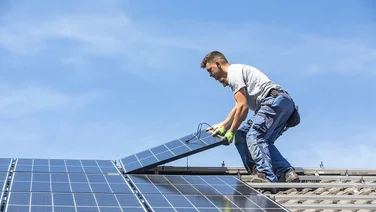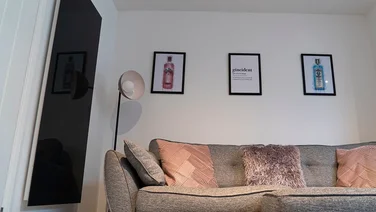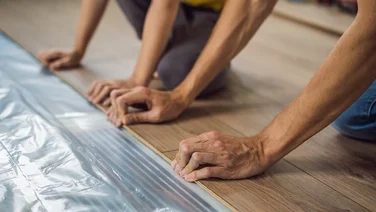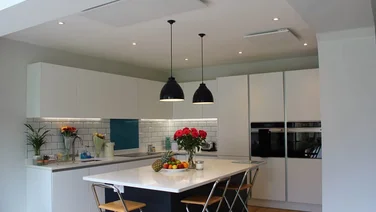- What are infrared heating panels?
- Should you get infrared heating panels?
- Is my property suitable for infrared panels?
- How expensive are infrared heating panels?
- Can I install infrared panels in a listed building?
- Do infrared heating panels work with solar panels?
- Pros and cons of infrared heating
- Summary
- Expect to spend around £495 per infrared heating panel
- Some of the best infrared panels have an efficiency rating of 112-115%
- Infrared panels generate fewer carbon emissions than gas boilers
One of the latest eco-heating systems to hit the industry is infrared heating panels. Fitting a whole home with infrared panels cost a little more than the average gas boiler, but they can lower household emissions and reduce energy bills.
That said, infrared panels aren’t for everyone. So if you want to know if they’re worth it for you, check out our helpful guide below.
Alternatively, if you think infrared panels would be perfect for your home, try our personalised quote tool to find the perfect set of panels. All you have to do is pop a few quick details in the form, and our expert installers will be in touch with free quotes.
Get free infrared panel quotes
Answer a few quick questions, and a trusted installer will be in touch with an infrared panel quote to heat your home.

Image credit: Cürv
What are infrared heating panels?
Not familiar with infrared heating panels? You’re not alone. Our National Home Energy Survey found that only 17% of Brits are aware of this low-carbon heating tech.
Infrared heating works very differently from traditional heating methods – rather than heating a room, as a conventional boiler does, it heats objects directly.
Large panels are propped up on the walls or ceilings, which release radiation and channel heat to specific areas of the property. Unlike modern radiators, these panels only take about 3–5 minutes to fully heat up when plugged in, so you don’t need to wait to get warm.
Infrared panels are also much easier to install than most traditional heating systems. An installer simply hardwires the panels into the electric circuit, which will allow you to use a switch (like a light switch) to turn them on.
Many infrared panel suppliers now include installation costs in the purchase price because of how quick and easy the process is. You can find out more about this on our infrared heating costs page.

Should you get infrared heating panels?
Although infrared heating panels are flying under the radar at the moment, they’re predicted to take off in the next few years – especially once the government’s gas boiler phase-out comes into effect.
There are plenty of pros to infrared panels, but they might not be for everyone. So, before you invest in these eco-friendly panels, it’s worth asking yourself a few questions.
Is infrared heating efficient?
Yes, infrared heating systems are very efficient.
Some of the best infrared panels have an efficiency rating of 112-115%, as opposed to just 100%.
Another thing that makes infrared more efficient than some other heating methods is the fact that users can ‘zone’ their heating. Zoning infrared heating systems basically means users can place panels in a strategical way to heat rooms that have high ceilings, are poorly insulated, or have draughty areas.
Want to go the extra mile? You can make your system even more efficient by installing infrared underfloor heating.
Is infrared heat better than electric?
Both electric and infrared heaters are high-quality appliances for heating homes – but infrared has the slight upper hand.
In terms of carbon emissions, both of these appliances run on electricity. This means that both heating methods will release the same amount of emissions when connected to the Grid.
Surely the same goes for savings, too? Well, not exactly. Although both of these appliances run on electricity, infrared is more efficient. An infrared heating unit converts 100% of the heat produced, compared to electric heaters converting only 80-90%.
Infrared panels are also much more aesthetically pleasing – they can be turned into mirrors, wall art, or even put out of the way onto the ceiling.
If you want to learn more about infrared panels and how they work, check out our Beginner’s Guide to Infrared Heating Panels.
Is my property suitable for infrared panels?
Good news: most homes are actually suitable for infrared heating. The panels themselves are affordable, small, and can be connected to existing electrical circuits, which makes them pretty ideal for most homes.
However, these panels are only effective if they don’t have something blocking their view, which can add some complexities when installing them in a smaller property.
To overcome this issue, many companies supply ceiling panels. They’re out of the way, not likely to be blocked by anything, and are light pieces of kit that won’t put a strain on the ceiling.
Unfortunately, infrared panels can’t fully replace boilers at the moment, since most models are unable to heat water. To overcome this issue, homeowners should couple infrared panels with a traditional electric immersion heater or water cylinder.
Some companies are also already developing infrared water-heating systems, which should become more popular in the coming years – so keep your eyes peeled.
How expensive are infrared heating panels?
Typically, you can expect the cost of an infrared heating panel to cost around £495, but this figure will fluctuate depending on the type of panel you go for, as well as its size, design, wattage.
On average, it would cost about £6,000 to fit a three-bedroom house with infrared panels.
But of course, these prices are just averages. You can find out how much infrared panels will cost you by using our easy-to-navigate quote tool. All you have to do is pop a few details in the form, and we’ll put you in touch with trusted installers, who’ll provide you with free bespoke quotes.
Unlike many other heating systems, installation costs are minimal, since infrared heaters are so simple to install. Some suppliers even add installation costs into the purchase price if you buy directly from them.
As for running costs? If you’re swapping a gas boiler for infrared panels, prepare for pricier energy bills. This is because, although infrared panels are efficient enough to help you save on energy bills, they also run on electricity – which is currently pricier than most other fuels.
For context, electricity is currently 28.62p per kWh, whilst gas is only priced at 7.42p per kWh, as of October 2023.
Want to learn more? Check out our comprehensive guide on infrared heating panel costs for more information.
Can I install infrared panels in a listed building?
Yes, you can install infrared panels in a listed building, which will likely come as a relief to anyone living in the estimated 500,000 listed buildings around the UK. These homeowners aren’t allowed to alter the aesthetic of the property, which often means they’re unable to install solar panels or heat pumps.
Since infrared panels look sleek and don’t take up much room, they have more of a chance of getting approved. On top of this, infrared panels can be transformed into mirrors or even have printed artwork on them, which makes them blend into the background even better.
However, listed buildings are limited in terms of insulation and double glazing upgrades, which may affect the efficacy of infrared.
Do infrared heating panels work with solar panels?
Want to make it even cheaper to heat your home? Try hooking your infrared panels up to some solar panels.
If you already have solar panels fixed to your roof, all you need to do is get an installer to connect infrared panels to the electrical circuit and you’ll be benefiting from free – or at least significantly cheaper – heating bills!
If you don’t currently have solar panels installed onto your property, you’ll need to invest a fair bit of money to do so – an average of £7,860 for a three-bedroom house, to be specific – but it could save you a lot on energy bills. Want to learn more? Head to our page on Solar Panel Costs.
Pros and cons of infrared heating
| Pros | Cons |
|---|---|
Low emissions | The whole system is more expensive than the average gas boiler |
Aesthetically pleasing | There can’t be any obstructions |
Don’t take up much space | Runs on electricity, which is expensive |
Simple to install | Can’t fully replace a boiler |
Low maintenance | |
More efficient than central heating systems | |
Reduce energy consumption with ‘zoning’ features | |
Can have health benefits | |
No noise pollution | |
Can be connected to solar panels | |
Can be installed in listed buildings |
Summary
Infrared heating certainly has a lot of potential – it’s affordable, looks appealing, has low emissions, and is suitable for most homes.
There are, however, some downsides to this eco-friendly bit of tech. As it stands, installing infrared panels is unlikely to fully replace your boiler, since the technology on infrared heating is still very early days, and can’t provide water heating yet.
But as more companies explore this new type of heating, water-heating infrared panels will become more popular, and will be able to provide UK homes with an affordable alternative to a gas boiler.
Think your home would be suitable for infrared heating panels? You can find the perfect set of panels by popping a few quick details in this short form. Once we’ve received your details, we’ll put you in touch with our expert installers, who’ll provide you with free, bespoke quotes.








